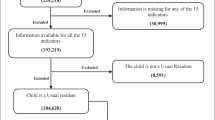Abstract
This study describes the multidimensionality of child poverty and produces the first multidimensional child poverty indices in North Macedonia. We use the Alkire-Foster method to develop two age-specific (0–4 years and 5–17 years) child multidimensional poverty indices (MPIs) by leveraging secondary data from Multiple Indicator Cluster Survey (MICS) 2018/2019 for North Macedonia and North Macedonia Roma Settlements. We find that the largest part of multidimensionally poor children are deprived within the range 33 − 39% of deprivations and the structure of multidimensional child poverty is similar for less, as well as for more intensely deprived children in both age-groups. Additionally, we identify the most deprived groups with respect to the area of living, ethnicity, and geographical location. The study provides general recommendations for policymakers to reduce child poverty in North Macedonia.








Similar content being viewed by others
Notes
MODA was used in all studies, except for Serbia.
The MICS 2018/2019 for North Macedonia and North Macedonia Roma Settlements covers different aspects of child well-being including health, nutrition, access to water and sanitation, child development, literacy and education, child protection and access to information among others, making it very appropriate for the child deprivation analysis. MICS is a household survey and child-related questions are derived from adult respondents. For more details, see https://www.stat.gov.mk/Dokumenti/MICS_18-19.pdf.
Sen (1993) defines capability as “… the capability of a person reflects the alternative combinations of functionings the person can achieve, and from which he or she can choose one collection.” While the functionings may span from elementary (e.g., adequate nutrition) to more complex (e.g., social inclusion), the poverty would relate to some basic capabilities whose set is context-dependent.
Qi & Wu (2019) provide brief history of the development of multidimensional measures of child poverty.
National legislation: Law on Child Protection, Family Law, Labor Code, Law on Social Protection, Law on Primary Education, Law on Health Insurance; National strategies/plans: National Youth Strategy 2016–2025, National Strategy for Reduction of Poverty and Social Exclusion 2010–2020, National Strategy for Prevention and Protection of Children from Violence (2020–2025) and its Action Plan (2020–2022), Strategic Plan 2021–2023 (Ministry of Labor and Social Policy).
If there is one or more missing indicators, other indicators in the dimension receive higher weights (Alkire & Santos, 2014). Moreover, the Education indicators are not applicable to the 5 years old children. We treat the children with non-applicable population as non-deprived in the relevant dimensions.
Percentage contribution of a dimension is the weighted ratio between censored headcount ratio of that dimension and adjusted headcount ratio.
Also, we calculate Cronbach’s alpha for the indicators of each age-group resulting in 0.47 for 0–4 age-group and 0.44 for 5–17 age-group. While Cronbach’s alpha has been extensively used in the literature, low coefficients of Cronbach’s alpha do not undermine the reliability of the designed indices (Santos & Villatoro, 2019). The main motivation behind calculation of multidimensional measures is a lower association between different kinds of deprivations.
References
Alkire, S., Apablaza, M., & Jung, E. (2014). Multidimensional poverty measurement for EU-SILC countries. OPHI Research in Progress 36c, Oxford Poverty and Human Development Initiative, University of Oxford
Alkire, S., & Foster, J. (2011). Counting and multidimensional poverty measurement. Journal of Public Economics, 95(7), 476–487. https://doi.org/10.1016/j.jpubeco.2010.11.006
Alkire, S., & Jahan, S. (2018). The new global MPI 2018: Aligning with the sustainable development goals. 121. https://ora.ox.ac.uk/objects/uuid:b57e734a-eb61-4f11-8cdc-347b1fdb947c
Alkire, S., Kovesdi, F., Pinilla-Roncancio, M., & Scharlin-Pettee, S. (2020). Changes over time in the global Multidimensional Poverty Index and other measures: Towards national poverty reports. OPHI Research in Progress 57a, Oxford Poverty and Human Development Initiative, University of Oxford
Alkire, S., & Roche, J. M. (2011). Beyond Headcount: Measures that Reflect the Breadth and Components of Child Poverty. OPHI Working Paper No. 45, Oxford Poverty and Human Development Initiative, University of Oxford
Alkire, S., Roche, J. M., & Vaz, A. (2017). Changes Over Time in Multidimensional Poverty: Methodology and Results for 34 Countries. World Development, 94, 232–249. https://doi.org/10.1016/j.worlddev.2017.01.011
Alkire, S., & Santos, M. E. (2014). Measuring Acute Poverty in the Develo** World: Robustness and Scope of the Multidimensional Poverty Index. World Development, 59, 251–274. https://doi.org/10.1016/j.worlddev.2014.01.026
Ben-Arieh, A. (2008). The Child Indicators Movement: Past, Present, and Future. Child Indicators Research, 1(1), 3–16. https://doi.org/10.1007/s12187-007-9003-1
Biggeri, M., Libanora, R., & Mariani, S., and, L. M (2006). Children Conceptualizing their Capabilities: Results of a Survey Conducted during the First Children’s World Congress on Child Labour. Journal of Human Development, 7(1), 59–83. https://doi.org/10.1080/14649880500501179
Chzhen, Y., & Ferrone, L. (2017). Multidimensional Child Deprivation and Poverty Measurement: Case Study of Bosnia and Herzegovina. Social Indicators Research, 131(3), 999–1014. https://doi.org/10.1007/s11205-016-1291-8
Ferrone, L., & de Milliano, M. (2018). Multidimensional child poverty in three countries in sub-Saharan Africa. Child Indicators Research, 11 (3) (2018), pp. 755–781
García, S., & Ritterbusch, A. (2015). Child Poverty in Colombia: Construction of a Multidimensional Measure Using a Mixed-Method Approach. Child Indicators Research, 8(4), 801–823. https://doi.org/10.1007/s12187-014-9274-2
Gordon, D., Nandy, S., Pantazis, C., Pemberton, S., & Townsend, P. (2003). Child poverty in the develo** world. Bristol: The Policy Press. https://aa.ecn.cz/img_upload/65636e2e7a707261766f64616a737476/Child_poverty.pdf
Hjelm, L., Ferrone, L., Handa, S., & Chzhen, Y. (2016). Comparing Approaches to the Measurement of Multidimensional Child Poverty. Office of Research – Innocenti Working Paper WP-2016-29. https://www.unicef-irc.org/publications/pdf/IWP_2016_29_2.pdf
Leu, C. H., Chen, K. M., & Chen, H. H. (2016). A multidimensional approach to child poverty in Taiwan. Children and Youth Services Review, 66, 35–44. https://doi.org/10.1016/j.childyouth.2016.04.018
de Neubourg, C., Chai, J., de Milliano, M., Plavgo, I., & Wei, Z. (2012). Step by Step Guidelines to the Multiple Overlap** Deprivation Analysis (MODA). Office of Research Working Paper WP-2012-10. UNICEF. https://www.unicef-irc.org/publications/pdf/iwp_2012_10.pdf
Pinilla-Roncancio, M., García-Jaramillo, S., Carrero, A. L., González-Uribe, C., & Ritterbusch, A. (2020). Child vs. Household MPIs in Colombia: Do they Identify the Same Children as Multidimensionally Poor? Child Indicators Research, 13(3), 777–799. https://doi.org/10.1007/s12187-019-09639-1
Pinilla-Roncancio, M., & Silva, R. (2018). Children in Angola: Poverty, Deprivation and Child Labour. Child Indicators Research, 11(3), 981–1005. https://doi.org/10.1007/s12187-017-9471-x
Qi, D., & Wu, Y. (2015). A multidimensional child poverty index in China. Children and Youth Services Review, 57, 159–170. https://doi.org/10.1016/j.childyouth.2015.08.011
Qi, D., & Wu, Y. (2016). The extent and risk factors of child poverty in urban China—What can be done for realising the Chinese government goal of eradicating poverty before 2020. Children and Youth Services Review, 63, 74–82. https://doi.org/10.1016/j.childyouth.2016.02.015
Qi, D., & Wu, Y. (2019). Comparing the Extent and Levels of Child Poverty by the Income and Multidimensional Deprivation Approach in China. Child Indicators Research, 12(2), 627–645. https://doi.org/10.1007/s12187-018-9544-5
Roche, J. M. (2013). Monitoring Progress in Child Poverty Reduction: Methodological Insights and Illustration to the Case Study of Bangladesh. Social Indicators Research, 112, 363–390. https://doi.org/10.1007/s11205-013-0252-8
Roelen, K. (2017). Monetary and Multidimensional Child Poverty: A Contradiction in Terms? Development and Change, 48(3), 502–533. https://doi.org/10.1111/dech.12306
Roelen, K. (2018). Poor Children in Rich Households and Vice Versa: A Blurred Picture or Hidden Realities? The European Journal of Development Research, 30(2), 320–341. https://doi.org/10.1057/s41287-017-0082-7
Roelen, K., & Camfield, L. (2013). A Mixed-Method Taxonomy of Child Poverty – the Case of Ethiopia. Applied Research in Quality of Life, 8(3), 319–337. https://doi.org/10.1007/s11482-012-9195-5
Roelen, K., & Gassmann, F. (2008). Measuring Child Poverty and Well-Being: A Literature Review (SSRN Scholarly Paper ID 1105652). Social Science Research Network. https://doi.org/10.2139/ssrn.1105652
Santos, M. E., & Villatoro, P. (2018). A Multidimensional Poverty Index for Latin America. Review of Income and Wealth, 64(1), 52–82. https://doi.org/10.1111/roiw.12275
Santos, M. E., & Villatoro, P. (2019). The Importance of Reliability in the Multidimensional Poverty Index for Latin America (MPI-LA). The Journal of Development Studies, 56(9), 1784–1789. https://doi.org/10.1080/00220388.2019.1663177
Sen, A. (1993). Capability and Well-Being. The Quality of Life. Oxford University Press. https://doi.org/10.1093/0198287976.003.0003
Trani, J. F., Biggeri, M., & Mauro, V. (2013). The Multidimensionality of Child Poverty: Evidence from Afghanistan. Social Indicators Research, 112(2), 391–416
United Nations Development Programme and Oxford Poverty and Human Development Initiative (2020). Global Multidimensional Poverty Index 2020 Charting pathways out of multidimensional poverty: Achieving the SDGs.http://hdr.undp.org/sites/default/files/2020_mpi_report_en.pdf
United Nations International Children’s Emergency Fund (2008). Child Poverty Study in FYR Macedonia. https://www.unicef.org/northmacedonia/media/1721/file/MK_SP_CP_ChildPovertyStudy_2008_EN.pdf
United Nations International Children’s Emergency Fund (2015a). Child Poverty in Serbia – The analysis of Multiple Indicator Cluster Survey data. https://www.unicef.org/serbia/media/4896/file/Child%20poverty%20in%20Serbia.pdf
United Nations International Children’s Emergency Fund (2015b). Wellbeing of children in Kosovo (UNSCR 1244) – Poverty and Deprivation among Children using Multiple Overlap** Deprivation Analysis (MODA). https://www.unicef.org/kosovoprogramme/media/171/file/MODA_ENG.pdf
United Nations International Children’s Emergency Fund (2021). Multidimensional Child Poverty in Montenegro – Understanding the complex realities of children in poverty using a mixed-method approach. https://www.unicef.org/montenegro/media/17696/file/UNICEF%20-%20MODA%20ENG%20-%20web.pdf.pdf
Vaz, A. (2015). How Many Children Live in Poverty? An Estimation of Global Child Multidimensional Poverty. OPHI Research in Progress 45a. University of Oxford
Author information
Authors and Affiliations
Corresponding author
Ethics declarations
Disclosure of Potential Conflicts of Interest
The authors declare that they have no conflicts of interest.
Research Involving Human Participants and/or Animals
This article does not contain any studies involving human participants or animals performed by any of the authors.
Informed Consent
This study was funded by UNICEF Office North Macedonia, under a service contract between UNICEF and Finance Think. A written consent has been obtained from UNICEF before submitting of the paper for publication.
Additional information
Publisher’s Note
Springer Nature remains neutral with regard to jurisdictional claims in published maps and institutional affiliations.
Rights and permissions
Springer Nature or its licensor holds exclusive rights to this article under a publishing agreement with the author(s) or other rightsholder(s); author self-archiving of the accepted manuscript version of this article is solely governed by the terms of such publishing agreement and applicable law.
About this article
Cite this article
Srbinoski, B., Petreski, B. & Petreski, M. Measurement of Multidimensional Child Poverty: Evidence from North Macedonia. Child Ind Res 16, 247–271 (2023). https://doi.org/10.1007/s12187-022-09967-9
Accepted:
Published:
Issue Date:
DOI: https://doi.org/10.1007/s12187-022-09967-9




